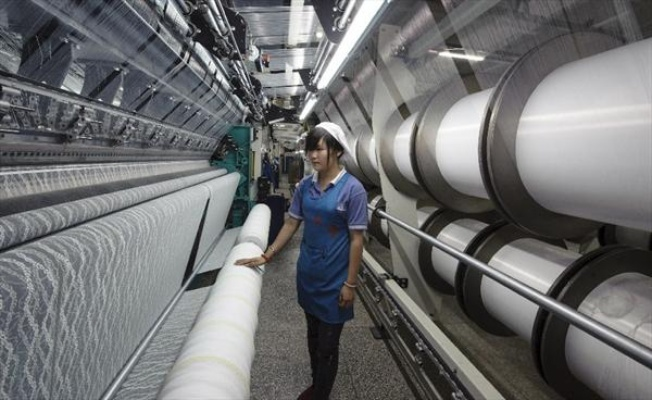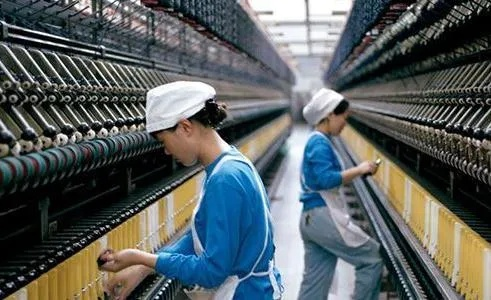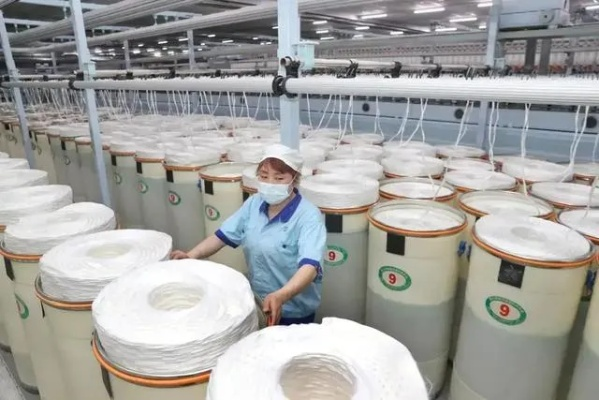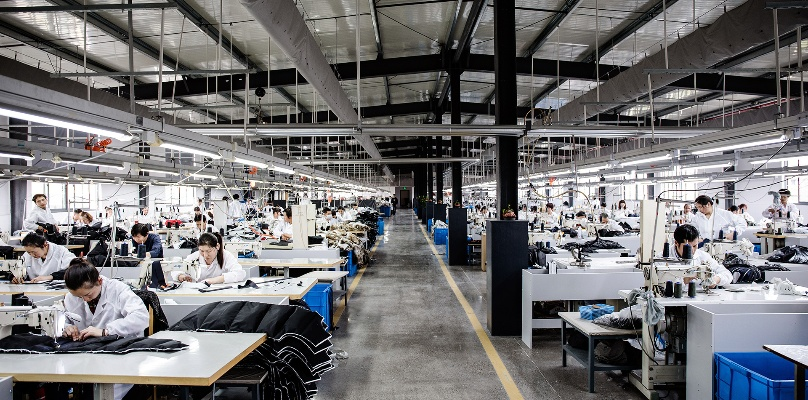The Entire Process of a Textile Factory
This article delves into the comprehensive process of a textile factory, highlighting the various stages from raw material procurement to finished product assembly. The initial phase involves selecting high-quality fibers and fabrics, followed by their processing in the milling and weaving stages. Subsequently, dyeing and finishing processes enhance the color and texture of the fabrics. The final stage sees the assembly of garments, which are then inspected for quality control before being packaged and dispatched to retailers worldwide. This comprehensive overview provides a detailed understanding of the textile industry's complexities and the meticulous attention required to ensure the highest standards of quality and craftsmanship.
Introduction: In the world of textiles, every thread and fabric is a testament to the meticulous craftsmanship that goes into producing high-quality products. From the initial raw materials to the finished garments, the entire process of a textile factory is an intricate dance of precision and dedication. Today, we will explore the various stages that make up this journey from raw material to finished product. Let's dive into the wonders of a textile factory and discover how each step contributes to the final masterpiece.
-
Preparation Stage: The first stage in the textile production process is preparation. This involves selecting the right type of cotton or other fibers for the yarn, which are then spun into threads. The quality of these raw materials significantly impacts the final product. For example, choosing high-quality cotton can result in softer and more durable fabrics.
-
Weaving Stage: Once the yarn is ready, it is time to weave it into fabric. This process involves interlacing the warp threads with the weft threads, creating a patterned surface. Depending on the type of fabric, different techniques like simple weave, twill, or ikat are used. For instance, a simple weave creates a flat surface, while a twill pattern provides a textured look.
-
Dyeing Stage: Dyeing is another crucial step in the textile industry. It involves treating the fabric with dyes to change its color. The choice of dye and the temperature at which it is applied can affect the final shade and durability of the fabric. For example, using natural dyes can create unique patterns and colors that cannot be replicated by synthetic dyes.

-
Finishing Stage: After dyeing, the fabric undergoes finishing treatments to enhance its appearance and protect it against wear and tear. This includes treatments like scouring, bleaching, and finishing with waxes or coatings. For instance, waxing adds a protective layer to the fabric, making it water-resistant and easy to clean.
-
Cutting Stage: Finally, the fabric is cut into various sizes and shapes to meet the needs of different industries. The cutting process involves using specialized machinery to ensure accuracy and precision. For example, in the apparel industry, different cuts are made for shirts, pants, and dresses, each with their unique specifications.
-
Packaging and Shipping Stage: Once the fabric has been cut and packaged, it is ready for shipping to retailers or manufacturers. The packaging should protect the fabric during transportation and ensure it arrives in good condition. In some cases, special care is taken to prevent damage during transport, such as using bubble wrap or corrugated cardboard.
-
Marketing and Sales Stage: After the fabric has been sold, marketing and sales play a vital role in ensuring its success. This involves promoting the product through various channels, such as social media, advertising, and trade shows. By effectively communicating the benefits of the product, businesses can attract customers and generate revenue.
-
End of Life: Finally, once the product has reached its end of life, it is recycled or disposed of properly. This ensures that the resources used in manufacturing the fabric are not wasted and contribute to sustainable growth in the industry.
Case Study: One example of a textile factory that embodies the entire process is the Pima Cotton Mill in Arizona, USA. This mill specializes in producing high-quality cotton fabrics using traditional methods. The mill's focus on sustainability and ethical practices has made it a leader in the industry. For instance, they use solar power to power their operations and prioritize fair labor practices throughout the supply chain. Their commitment to quality and sustainability has earned them recognition from both consumers and environmental organizations alike.
Conclusion: The textile industry is a complex but fascinating field that requires careful attention to detail and innovation. Each stage of the process plays a critical role in transforming raw materials into beautiful, functional products that satisfy our needs. By understanding the importance of each stage and striving for excellence in each step, we can continue to produce textiles that inspire and delight people around the world.
纺织厂全工序概述
纺织厂是一个涵盖了从原材料收集到最终成品出库的完整生产链条,在这个链条中,涵盖了从纺纱、织造、染整到成衣缝制等各个环节,以下是对纺织厂全工序的详细介绍。
纺纱工序
纺纱工序是纺织生产的第一步,主要任务是将各种纤维原料通过机械手段转化为纱线,在这个工序中,主要使用的设备包括纺纱机、罗拉、牵伸装置等。
设备介绍
纺纱机:这是一种高效、连续的纺织机械,能够精确地将纤维原料转化为纱线。 罗拉:用于将纱线牵引并固定在织布机上。 牵伸装置:用于调整纱线的长度和形状,确保纱线的均匀性和舒适性。
案例说明:某纺织厂采用先进的纺纱技术,使用高效纺纱机,确保每根纱线的质量都达到高标准,该厂还采用了先进的牵伸装置,使得纱线的长度和形状更加均匀,提高了产品的质量和舒适度。
操作流程
原料准备:根据产品需求,选择合适的纤维原料。 原料混合:将纤维原料混合均匀。 纺纱:使用纺纱机将纤维原料转化为纱线。
织造工序
织造工序是将纱线按照设计要求编织成布的过程,在这个工序中,主要使用的设备包括织布机、针织设备等。
设备介绍

织布机:一种自动化程度高的织布机械,能够根据设计要求精确地编织出各种图案和纹理的布。 针织设备:用于生产各种针织面料,如棉布、丝绸等。
案例说明:某纺织厂采用先进的织造技术,使用高效织布机和针织设备,生产出各种高质量的纺织品,满足了市场的多样化需求。
操作流程
设计图纸确认:根据产品需求和设计要求,确定织造工艺和图案。 原料准备:将所需原料按照设计要求进行准备。 织造:使用织布机将原料编织成布。 印染:根据需要,对织物进行印染处理,提高产品的颜色和质感。
染整工序
染整工序是纺织生产过程中的重要环节,主要任务是将织物进行染色和整理,提高产品的质量和外观美感,在这个工序中,主要使用的设备包括染化料生产设备、染色设备、整理设备等。
设备介绍
染化料生产设备:用于生产染料和其他染色助剂。 染色设备:一种高温染色设备,能够精确地将染料染色到织物表面。 整理设备:用于对织物进行整理,如防水、防皱等处理。
案例说明:某纺织厂采用了先进的染整技术,使用高效染化料生产设备和染色设备,使得织物的颜色鲜艳、质地柔软舒适,该厂还采用了先进的整理技术,使得织物具有防水、防皱等特殊功能。
操作流程
原料准备:根据产品需求和染整要求,准备所需的染料和其他染色助剂。 染色处理:将染料均匀地染色到织物表面。 整理处理:根据需要,对织物进行防水、防皱等处理。 质量检测:对染整后的产品进行质量检测,确保产品质量符合标准。
成衣缝制工序
成衣缝制工序是将经过染整处理的织物缝合成成品的过程,在这个工序中,主要使用的设备包括缝纫机、缝制辅助工具等。
设备介绍
缝纫机:一种自动化程度高的缝制机械,能够精确地将织物缝合成各种形状和图案的成品。 缝制辅助工具:用于辅助缝制过程,如线针、夹具等。
案例说明:某纺织厂采用了先进的缝制技术,使用高效缝纫机和缝制辅助工具,使得成品的质量和外观都达到了高标准,该厂还注重环保和节能,采用环保材料和节能设备,降低了生产成本和能源消耗。
操作流程
设计图纸确认:根据产品需求和设计要求,确定成品形状和图案。 原料准备:将经过染整处理的织物准备好。 缝制:使用缝纫机将织物缝合成成品。 质检:对成品进行质量检测,确保产品质量符合标准。 包装出货:将成品进行包装和出货。 纺织厂全工序涵盖了从原材料收集到最终成品出库的完整生产链条,每个环节都非常重要,在纺织生产过程中,需要注重环保和节能,采用先进的技术和设备,提高生产效率和产品质量,还需要注重产品质量检测和质量控制,确保产品质量符合标准。
Articles related to the knowledge points of this article:
Breaking Barriers:A Day in the Life of Women at Changle Textile Factory
The Story of Textile Mills Line Bars



